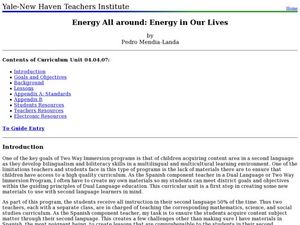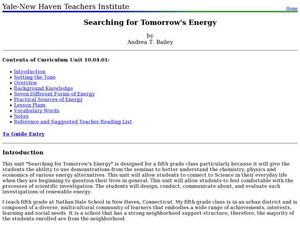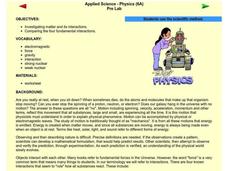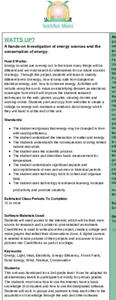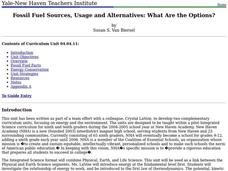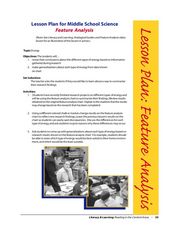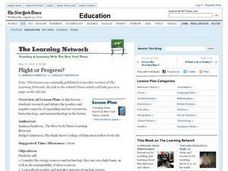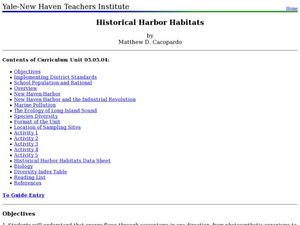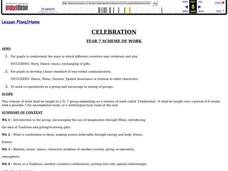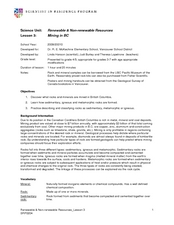Curated OER
The Transfer of Energy 2: Electrochemistry
Students study about electrochemistry by increasing their understanding of electron transfer and its role in chemical changes. They explain that energy appears in different forms. Heat energy is in the disorderly motion of molecules.
Curated OER
Energy All Around: Energy in Our Lives
Students identify the different sources of energy. In this energy lesson, students list different machines and identify the type of energy used to operate them. They create a diagram of a wind turbine and label its parts.
Curated OER
Energy
Scientific terms can be difficult to remember. This resource suggests developing analogies as a way to make energy terms memorable. After listing new terms on the board, groups develop analogies based on restaurant words, and then share...
Curated OER
Renewable Energy Sentences
Students construct sentences using nouns and verbs from a "renewable energy" word bank. In this cross curriculum ecology and sentence structure grammar and mechanics lesson plan, students listen to the book Our Earth: Clean Energy by...
Curated OER
Searching for Tomorrow's Energy
Fifth graders investigate energy. In this biology lesson plan, 5th graders will learn about energy, fossil fuels, and renewable and nonrenewable resources. Students will be participating in three lab activities which are described in...
Curated OER
Matter and Energy
Students explore energy by completing a science worksheet in class. For this principles of matter lesson, students define the vocabulary terms force, gravity, nuclear, and electromagnetic before reading assigned text about energy....
Curated OER
Energy Detectives
Students explore where energy comes from and identify the different kinds of energy. In this energy lesson students search their classroom for energy connections and record the way that they use energy.
Curated OER
Renewable Energy
Students examine the United States' current and future energy needs. They describe different forms of renewable energy sources and compare the impacts of renewable and non-renewable energy sources on the earth and society.
Curated OER
Grass as Biomass
Students explore energy properties by listening to a sustainability lecture in class. In this biomass instructional activity, students identify what biomass is, how it can be transformed into a usable energy and how it complements the...
Curated OER
Energy Forms
Young scholars explore energy by participating in a science lab in class. In this energy form lesson, students define the different types of energy such as light, mechanical and sound while examining energy measuring tools in class....
Curated OER
Weather or Not...
Pupils observe many different types of weather conditions, they become aware of variations in sunlight, clouds, wind, and forms of moisture. They discover the techniques, brush strokes, and colors that artists such as Charles Burchfield,...
Curated OER
WATTS UP?
Second graders research the Internet as they classify different forms of energy, investigate electrical energy and how to conserve energy.
Curated OER
Chilling Out
Students determine the breakdown of worldwide energy consumption by various sources. After reading an article, they examine recent research in the area of alternative energy sources. Using the internet, they research the forms of...
Curated OER
Fossil Fuel Sources, Usage and Alternatives: What are the Options?
Students identify the different sources of fossil fuels. In this environmental science lesson, students research about how these impact our environment. They explore renewable energy sources that could replace fossil fuels.
Curated OER
Feature Analysis
Students research and analyze energy. In this energy lesson plan, students research types of energy and complete a feature analysis chart using chalk or markers. Students write generalizations about each type of energy based on their chart.
Curated OER
Unit 2 Sun & Stars
Students describe stellar objects using terms such as stars, planets, satellites, orbits and light. In this sun and stars unit, students research stellar objects through seven individual lessons discovering star characteristics, how...
Playbooks
Reader's Theater Exercise: The Night Before Christmas
Yes, Virginia, there really is a reader's theater script for "The Night Before Christmas." The exercise is a great way to productively channel pre-holiday energy.
Carnegie Mellon University
Debate
Set your environmental studies class up to debate a current topic regarding your choice of six suggested statements about energy use in the United States. Teams read material that you have gathered and then form their arguments. The...
Curated OER
Go To The Head of the Cloud
Students pretend they are water droplets traveling through the water cycle. Using their text, they discover the steps in the cycle and the different paths water can take. They write a report about their journey through the water cycle...
Curated OER
Plight or Progress?
Students read an online article to study the positive and negative aspects of nuclear energy, biotechnology, and nanotechnology. They conduct a debate on technology of the future.
Curated OER
Historical Harbor Habitats
Tenth graders create food web displays in the classroom. In this ecology instructional activity, 10th graders identify the different pollutants in the environment and their effect on organisms. They collect samples of sediments from the...
Curated OER
Celebration
Students identify the different ways in which different countries celebrate and why, including story, dance, music, and exchanging gifts. Then they develop a basic standard of non-verbal communication through either dance, mime,...
Curated OER
Renewable and Non-Renewable Resources: Mining in B.C.
Students explore energy by categorizing rocks. In this British Columbia geology lesson, students define many different vocabulary terms associated with mining such as sedimentary, igneous, and metamorphic. Students utilize sample rock...
Curated OER
Hand Writing: Three Letter Words
In this printing practice worksheet, students trace, form, and print three letter words. Students practice printing ten separate words.

